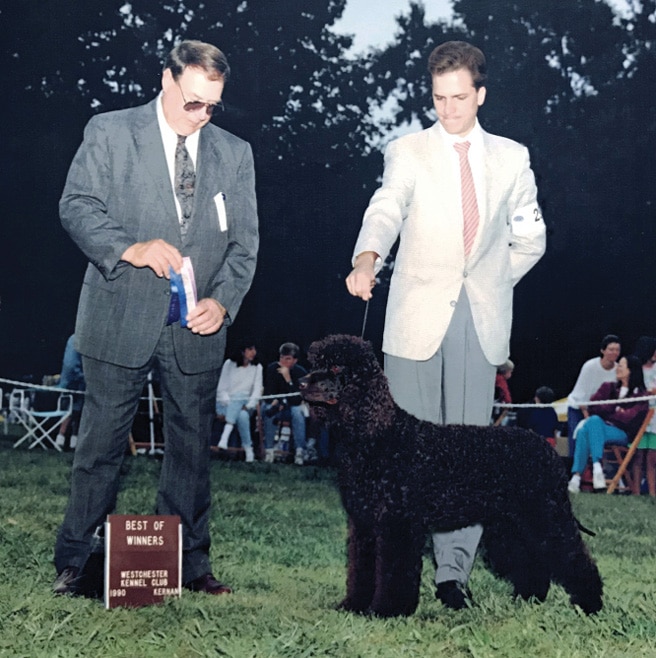“When are you going to breed her?” This innocuous question was asked of me on the day I finished my first owner-handled show dog. I’d just had the official win photo taken when a second-generation breeder innocently inquired about my future plans for my (now champion) Irish Water Spaniel. The lady’s question caught me off-guard. I hadn’t made plans for my young bitch beyond earning her conformation championship, so the thought of breeding her (much less raising a litter) hadn’t even crossed my mind. Now, with the idea before me, I had a decision to make; one that required a plan.
Some owner handlers begin like me, with little or no thought about becoming a breeder. They move through the sport from show to show, collecting ribbons and titles as they go. Some join the ranks of performance competitors, embracing activities that are really, really FUN—and don’t require pants with pockets or pantyhose! Others, like me, enjoy the conformation ring and have a fundamental affinity for the “original” sport. For us, there are few things better than watching a knowledgeable judge sort through a class consisting of quality animals. (Okay, maybe winning such a class is better… and it’s far better still if that class is Bred-By!) And that’s the whole point, isn’t it? Assessing “breeding stock” is the reason dog shows came into being and it’s why they’re still here. And without purebred dog breeders, there wouldn’t be any dog shows at all—other than those requiring weave poles, bales of hay or pools filled with 30,000 gallons of water.
Until relatively recently, conformation shows and obedience trials were the only places where the dog-loving public could go to be introduced to the wide world of purebred dogs. In the “good ole days,” clubs placed ads for their upcoming shows in local papers and, as if by magic, the public came in droves. Ringside and on the bench, conversations took place between potential puppy buyers and purebred dog breeders. Phone numbers were exchanged and followed up with actual phone calls. (Remember phone calls?) Hand-written letters were also exchanged and photos shared. (Photo sharing simply required a postage stamp and a trip to the post office.) Eventually, litters of puppies were produced and, ultimately, a few of their puppy people—after waiting several years to receive word of the new arrivals—would find themselves in the show ring with their long-awaited pup, encouraged in their new activity by their dog’s breeder. These novice owner handlers entered a rarified world where they met other exhibitors who’d gladly spend the entire day just “talking dogs” and making plans to attend upcoming shows. Friendships were also made with more experienced owner handlers, some of whom were breeders who grew up in the sport. These veteran exhibitors could easily recognize a dog-loving rookie with the potential for remaining committed. This is how things happened with me when I didn’t even know that I wanted to breed dogs or if I even had what it took to care for a pregnant bitch and her litter of puppies.
My new dog’s very existence
was the result of decisions
I’d made as part of a plan..
Thankfully, I did decide to take the plunge into the whelping box. With no experience whatsoever, I managed to raise a litter of 10 and placed each pup in a loving home—not an easy thing to do with a rare breed in the “olden days.” I also kept a pup of my own that became my first owner-handled champion. That experience was different for me than was finishing his dam. It actually “felt” different. After all, my bred-by champion was the result of decisions more carefully made. (I’d purchased his mother simply because I wanted a companion to show. Easy!) My new dog’s very existence was the result of decisions I’d made as part of a plan: The health of his mother was verified because I’d chosen to test her for disease; the selection of his sire was based on similar testing and on a less than scholarly review of both parents’ pedigrees; and the placement of each puppy was based on information gathered by temperament testing as well as through daily observations. Each pup was the result of individual decisions that were, collectively, part of a greater plan. For me, the transition from owner handler to breeder changed the trajectory of my life in dogs. It helped me to realize that puppies can be purchased from someone else or they be the result of a series of informed decisions that I’ve made as part of a plan.
The best laid plans, however, require updating from time to time. Today’s (dog) world is a much different place than it was when I bred my first litter. In 1988, information about upcoming shows arrived through “snail mail” and litter announcements were placed in club newsletters. Puppy inquiries were made by phone or answered through hand-written letters, and show results (not to mention show photos) took weeks to arrive. Now, in 2021, social media has largely replaced these antiquated forms of communication. Websites offer information about breeders and their dogs, and emails, text messages, and social messaging services have largely replaced both the phone and the need for mail carriers. Online retailers have even made visits to the pet supply stores obsolete. We now live in a world where life can be lived “virtually.” And this is why activities like dog shows (those that require some degree of planning and actual interaction with other people) are vitally important. The sport of dogs allows us to set goals beyond the desire to check our email and post a few photos—not to mention actually having to leave the house. Dog shows provide a good excuse to get dressed in good clothes (and bad shoes) on a Saturday morning to meet up with other dog people to formulate strategies and makes plans for next weekend—and the next litter.
Of course, breeding dogs requires quite a bit more planning than deciding which shows to enter and what to wear. After all, producing the next generation of purebred dogs can be fraught with surprises and should only be carefully considered; thus, the need for planning. However, breeding your own family of dogs can be infinitely more rewarding than standing in the pouring rain in the middle of a fairground with a wet ribbon in hand. Providing purebred puppies for the world to enjoy offers hope for the future and strengthens our connection to other people who share our commitment to the sport and our passion for the breed(s) we love. Bred-by puppies also introduce novice owner handlers (like you and me) to the possibility of setting our own course as breed custodians. Without a plan for the future, we might never know the impact we can make on behalf of purebred dog preservation.
So, when are you going to breed her?










